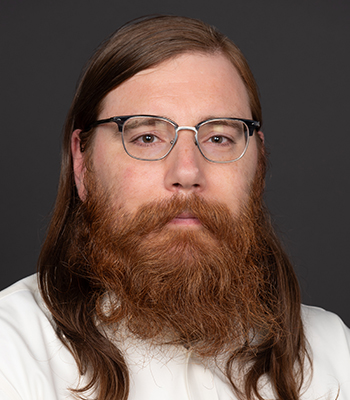Matthew J. Allen (dv3651)
University information
Contact information
Cancer Biology Program
https://allengroup.wayne.edu/
- Hypoxia
- Contrast agents for magnetic resonance imaging
- Lanthanide chemistry
- Molecular imaging
The Allen laboratory explores the chemistry of the lanthanides relevant to magnetic resonance imaging (MRI) and catalysis. We are at the frontier of inorganic chemistry intersecting with organic synthesis, analytical chemistry, oncology, and biology. Three major aims in the group are to overcome critical barriers to the advanced use of lanthanide-based contrast agents for MRI; to elucidate mechanistic details of lanthanide-catalyzed organic reactions to help generate improved catalysts; and to find sustainable sources of the lanthanides. These projects will illuminate fundamental properties of lanthanides. Additionally, they are an inroad toward greatly enhancing the molecular imaging and diagnostic capabilities of MRI and increasing the quality and number of more environmentally benign catalysts for the synthesis of organic molecules.
Subasinghe, S. A. A. S.; Ortiz, C. J.; Romero, J.; Ward, C. L.; Sertage, A. G.; Kurenbekova, L.; Yustein, J. T.; Pautler, R. G.; Allen, M. J. Toward quantification of hypoxia using fluorinated Eu(II/III)-containing ratiometric probes. Proc. Natl. Acad. Sci. U.S.A. 2023;120:e2220891120.
Lutter, J. C.; Batchev, A. L.; Ortiz, C. J.; Sertage, A. G.; Romero, J.; Subasinghe, S. A. A. S.; Pedersen, S. E.; Samee, M. A. H.; Pautler, R. G.; Allen, M. J. Outersphere approach to increasing the persistance of oxygen-sensitive europium(II)-containing contrast agents for magnetic resonance imaging with perfluorocarbon nanoemulsions toward imaging of hypoxia. Adv. Healthc. Mater. 2023;12:e2203209.
Batchev, A. L.; Rashid, M. M.; Allen, M. J. Divalent europium-based contrast agents for magnetic resonance imaging in Handook on the Physics and Chemistry of Rare Earths, Volume 63, Elsevier, 2023;55–98.
Rashid, M. M.; Corbin, B. A.; Jella, P.; Ortiz, C. J.; Samee, M. A. H.; Pautler, R. G.; Allen, M. J. Systemic delivery of divalent europium from ligand screening with implications to direct imaging of hypoxia. J. Am. Chem. Soc. 2022;144:23053-60.
Bailey, M. D.; Jin, G.-X.; Carniato, F.; Botta, M.; Allen, M. J. Rational Design of High Relaxivity Eu(II)-Based Contrast Agents for Magnetic Resonance Imaging of Low-Oxygen Environments. Chem. Eur. J. 2021;27:3114-8.
Pierre, V. C., Allen, M. J., Eds.; Contrast Agents for MRI: Experimental Methods; Royal Society of Chemistry: Cambridge, U.K. 2018.
B.S. in Chemistry, 1998, Purdue University
Ph.D. in Chemistry, 2004, California Institute of Technology

College of Liberal Arts and Sciences
Chem 243
Lanthanide chemistry, contrast agents for magnetic resonance imaging, catalysis, molecular imaging, coordination chemistry
Research in the Allen laboratory explores the chemistry of magnetic resonance imaging (MRI) and asymmetric catalysis. We are at the frontier of inorganic chemistry intersecting with organic synthesis, analytical chemistry, and biology. Because of the multidisciplinary approach to science in the laboratory, group members are exposed to a wide variety of synthetic and analytical techniques from chemical and biological disciplines. Specifically, projects in the group require the synthesis of inorganic and organic molecules; characterization of these compounds using a variety of techniques including multinuclear NMR spectroscopy, mass spectrometry, fluorescence spectroscopy, and cyclic voltammetry; and compound testing through catalytic transformations or in vitro and in vivo imaging experiments.
Two major aims in the group are (1) to overcome critical barriers to the advanced use of lanthanide-based contrast agents for MRI and (2) to elucidate mechanistic details of water-tolerant lanthanide-catalyzed organic reactions with the goal of generating improved catalysts.
Magnetic resonance imaging
MRI can be used to noninvasively visualize the inside of living organisms. This property of MRI has greatly advanced the ability to diagnose disease and evaluate medical conditions. Lanthanide complexes can enhance inherent contrast in MR images through interactions with solvent molecules. Through the selective enhancement of contrast, MRI can be converted into an even more powerful tool for imaging biological events on the molecular level (molecular imaging); however, there are major limitations to the use of existing rare earth complexes in improving the diagnostic capabilities of MRI and in the study of complicated biological systems. To overcome these limitations, our laboratory uses novel coordination chemistry to manipulate the properties of lanthanide ions. Specifically, we are interested in controlling the magnetic and electronic interactions of lanthanide ions with their surrounding environment and in stabilizing unstable oxidation states. These projects will illuminate fundamental properties of lanthanides. Additionally, they are an inroad toward greatly enhancing the molecular imaging and diagnostic capabilities of MRI.
Asymmetric catalysis
The use of water-tolerant catalysts is of great consequence in synthesizing organic molecules in a more environmentally benign manner. The Allen laboratory is interested in the study of lanthanide-based, water-tolerant, asymmetric catalysts for organic transformations including aldol, Mannich, and Diels-Alder reactions. Over the last decade, the use of lanthanide triflates as water-tolerant catalysts for organic transformations has been developed; however, mechanistic details of these reactions are largely unknown. During the development of these catalysts, the field of MRI inspired the generation of advanced techniques for characterizing and manipulating the properties of lanthanide ions. Our group is working at the intersection of these two fields to design and study lanthanide triflate-based catalysts with high enantioselectivity and water-stability. By studying and improving lanthanide-based catalysts, we hope to increase the quality and number of more environmentally benign catalysts for the synthesis of organic molecules.
- Subasinghe, S. A. A. S.; Ortiz, C. J.; Romero, J.; Ward, C. L.; Sertage, A. G.; Kurenbekova, L.; Yustein, J. T.; Pautler, R. G.; Allen, M. J. Toward quantification of hypoxia using fluorinated Eu(II/III)-containing ratiometric probes. Proc. Natl. Acad. Sci. U.S.A. 2023;120:e2220891120
- Lutter, J. C.; Batchev, A. L.; Ortiz, C. J.; Sertage, A. G.; Romero, J.; Subasinghe, S. A. A. S.; Pedersen, S. E.; Samee, M. A. H.; Pautler, R. G.; Allen, M. J. Outersphere approach to increasing the persistance of oxygen-sensitive europium(II)-containing contrast agents for magnetic resonance imaging with perfluorocarbon nanoemulsions toward imaging of hypoxia. Adv. Healthc. Mater. 2023;12:e2203209
- Batchev, A. L.; Rashid, M. M.; Allen, M. J. Divalent europium-based contrast agents for magnetic resonance imaging in Handbook on the Physics and Chemistry of Rare Earths, Volume 63, Elsevier, 2023;55–98
- Rashid, M. M.; Corbin, B. A.; Jella, P.; Ortiz, C. J.; Samee, M. A. H.; Pautler, R. G.; Allen, M. J. Systemic delivery of divalent europium from ligand screening with implications to direct imaging of hypoxia. J. Am. Chem. Soc. 2022;144:23053-60
- Bailey, M. D.; Jin, G.-X.; Carniato, F.; Botta, M.; Allen, M. J. Rational Design of High Relaxivity Eu(II)-Based Contrast Agents for Magnetic Resonance Imaging of Low-Oxygen Environments. Chem. Eur. J. 2021;27:3114-8
- Pierre, V. C., Allen, M. J., Eds.; Contrast Agents for MRI: Experimental Methods; Royal Society of Chemistry: Cambridge, U.K. 2018
